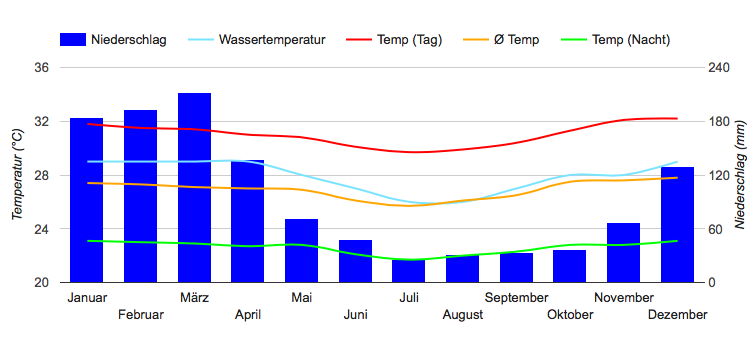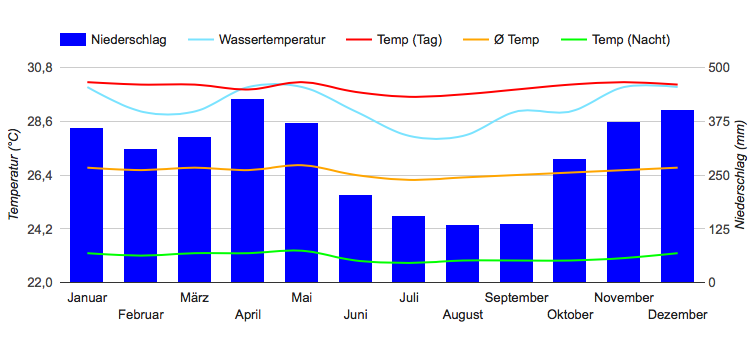![Homeless boys at City Mission Farm learning various vocational skills. (Department of Foreign Affairs and Trade) [flickr.com] CC BY
License Information available under 'Proof of Image Sources' Homeless boys at City Mission Farm learning various vocational skills. (Department of Foreign Affairs and Trade) [flickr.com] CC BY
License Information available under 'Proof of Image Sources'](/wp-content/uploads/reiseziele/homeless-boys-at-city-mission-farm-learning-various-vocational-skills88646.jpg)
Furthermore, we analyzed all climate data and provide a recommendation about which months are best to visit Papua New Guinea for your holiday.
Climate Overview
 22 °C to 32 °C
22 °C to 32 °C 26 °C to 30 °C
26 °C to 30 °C 1.02 – 16.89 in (3 – 19 Days of Rain)
1.02 – 16.89 in (3 – 19 Days of Rain)Average Annual Temperature is between 26.5 °C (Madang) and 26.9 °C (Port Moresby)
Show temperatures in degree
Geographical location
Table of Contents
Papua New Guinea is the third largest island state in the world in terms of area and has about 7.5 million inhabitants.
Geographically it belongs to Australia and is surrounded by the Pacific Ocean. Papua New Guinea consists of the eastern half of the island New Guinea (the west belongs to Indonesia) as well as several offshore island groups.
The landscape is very mountainous, highest point of the country is Mount Wilhelm with about 4500 meters height. Papua New Guinea has a very diverse landscape. The mountains are characterised by great differences in altitude, there are valleys, glaciers, volcanoes, forests and rainforests.
The regions between the mountains and the coast are extremely fertile. On the north coast of the island of New Guinea there are large coral reefs and a breathtaking underwater world.
Together with other islands such as the Mariana Islands and Palau, the country formed a colony of the German Empire (German New Guinea) until the end of the First World War. However, the official German language was quickly replaced by Australia, and today English is the official language in Papua New Guinea.
Travel to Papua New Guinea is generally by Air Niugini from Australia, Singapore or Bangkok.
Climate in Papua New Guinea
![20100228_3_Haruro_welcome_011 (Christopher John SSF) [flickr.com] CC BY
License Information available under 'Proof of Image Sources'](/wp-content/uploads/reiseziele/201002283harurowelcome01146927_preview.jpg) A tropical, humid and hot climate prevails on the coasts of Papua New Guinea. The hottest months are December and January with peaks of up to 39 °C. In the mountains of the island the temperatures are noticeably lower than on the coasts. The climate changes from an altitude of about 1500 meters from the tropical to the temperate climate and at night it can even come to frost in the high altitudes.
A tropical, humid and hot climate prevails on the coasts of Papua New Guinea. The hottest months are December and January with peaks of up to 39 °C. In the mountains of the island the temperatures are noticeably lower than on the coasts. The climate changes from an altitude of about 1500 meters from the tropical to the temperate climate and at night it can even come to frost in the high altitudes.
An alpine climate begins at an altitude of over 2,000 metres, with snow on some of the peaks of the mountains in Papua New Guinea all year round. Generally there is much higher rainfall on the islands from December to April, spring is considered the main rainy season. From May, the rainfall will decrease significantly, in the south of the country it will remain particularly dry between the end of May and November.
Best Time to Visit Papua New Guinea: Overview
JanuaryJan Up to 14.21 in of rainof rain | FebruaryFeb Up to 12.28 in of rainof rain | MarchMar Up to 13.43 in of rainof rain | AprilApr Up to 16.89 in of rainof rain | MayMay Good time to traveltime PerfectPerf. climate in Port Moresby | JuneJun Good time to traveltime PerfectPerf. climate in Port Moresby |
JulyJul Best time to traveltime PerfectPerf. climate in Port Moresby Madang | AugustAug Best time to traveltime PerfectPerf. climate in Port Moresby Madang | SeptemberSep Best time to traveltime PerfectPerf. climate in Port Moresby Madang | OctoberOct Good time to traveltime PerfectPerf. climate in Port Moresby | NovemberNov Good time to traveltime PerfectPerf. climate in Port Moresby | DecemberDec Up to 16.22 in of rainof rain |
When to travel to Papua New Guinea?
The best time to travel to the island state of Papua New Guinea is the dry season between May and mid-November, with the travel season between June and September providing ideal travel conditions for the whole country.
Especially at the southern coast it is very sunny, there is little precipitation and the temperatures are mostly around 26 °C.
A trip between December and April is generally not recommended, as tropical cyclones can occur in addition to torrential rainfall and roads that are difficult to pass.
Best Time to Visit the Regions
Find the best time to visit the regions (Papua New Guinea) in the following overview.| Location | Best Time to Travel |
|---|---|
| Port Moresby | May, June, July, August, September, October, and November |
| Madang | July, August, and September |
Climate Charts Papua New Guinea
In the following, you will find climate charts for the regions.
Furthermore, there are some charts you can use for quick comparison of climate between the regions.
Show Climate Chart for
Port Moresby

Show temperatures in degree
Source of Data: German Weather Service (Offenbach) and Wikipedia
Climate Tables Papua New Guinea
In the following, you will find some climate tables for Papua New Guinea, containing information about Temperatures, Precipitation, Water Temperatures, and Hours of Sunshine.Show climate table for
Temperatures, Precipitation, Sunshine in Port Moresby (Papua New Guinea)
| Jan | Feb | Mar | Apr | May | Jun | Jul | Aug | Sep | Oct | Nov | Dec | |
|---|---|---|---|---|---|---|---|---|---|---|---|---|
| Day Temperature | 32° | 32° | 31° | 31° | 31° | 30° | 30° | 30° | 30° | 31° | 32° | 32° |
| Night Temperature | 23° | 23° | 23° | 23° | 23° | 22° | 22° | 22° | 22° | 23° | 23° | 23° |
| Water Temperature | 29° | 29° | 29° | 29° | 28° | 27° | 26° | 26° | 27° | 28° | 28° | 29° |
| Precipitation (inch) | 7.24 | 7.6 | 8.35 | 5.39 | 2.83 | 1.89 | 1.02 | 1.22 | 1.3 | 1.46 | 2.64 | 5.12 |
| Rainy days | 15 | 14 | 14 | 10 | 8 | 4 | 4 | 3 | 4 | 4 | 6 | 9 |
| Hours of Sunshine | 6 | 6 | 6 | 7 | 7 | 7 | 7 | 7 | 7 | 8 | 8 | 7 |
Show temperatures in degree
Temperatures
The annual average temperature in Port Moresby is 26.9 °C.For comparison: London 11 °C, NYC 12 °C, LA 17.9 °C
Warmest month: December (27.8 °C)
Coldest month: July (25.7 °C)
The maximum water temperature in Port Moresby is 29 °C. You can take a bath at these temperatures.
Months with water temperature of at least 21 °C (adequate for beach vacation):
all months
Precipitation
Overall annual precipitation: 46.06 inch on 95 rainy daysFor comparison: London 24.06 in, NYC 41.57 in, LA 12.01 in
Rainy season (months with more than 6.9 in of precipitation): January, February, and March
Overall precipitation in the rainy season: 23.19 in
You cannot expect snow in any month in Port Moresby.
Sunshine
As our climate table shows, November is the sunniest month with an average of 8.1 hours of sunshine per day. Over the year, there are 6.8 hours of sunshine per day on average. For comparison: London has 4.1, NYC has 7 and LA has 8.9 hours of sunshine per day on average.Temperatures, Precipitation, Sunshine in Madang (Papua New Guinea)
| Jan | Feb | Mar | Apr | May | Jun | Jul | Aug | Sep | Oct | Nov | Dec | |
|---|---|---|---|---|---|---|---|---|---|---|---|---|
| Day Temperature | 30° | 30° | 30° | 30° | 30° | 30° | 30° | 30° | 30° | 30° | 30° | 30° |
| Night Temperature | 23° | 23° | 23° | 23° | 23° | 23° | 23° | 23° | 23° | 23° | 23° | 23° |
| Water Temperature | 30° | 29° | 29° | 30° | 30° | 29° | 28° | 28° | 29° | 29° | 30° | 30° |
| Precipitation (inch) | 14.17 | 12.28 | 13.39 | 16.89 | 14.61 | 8.07 | 6.14 | 5.28 | 5.39 | 11.34 | 14.76 | 15.83 |
| Rainy days | 19 | 17 | 19 | 18 | 19 | 16 | 12 | 9 | 10 | 14 | 17 | 19 |
| Hours of Sunshine | 5 | 5 | 5 | 6 | 6 | 7 | 6 | 7 | 8 | 7 | 6 | 5 |
Show temperatures in degree
Temperatures
The annual average temperature in Madang is 26.5 °C.Warmest month: May (26.8 °C)
Coldest month: July (26.2 °C)
The maximum water temperature in Madang is 30 °C. You can take a bath at these temperatures.
Months with water temperature of at least 21 °C (adequate for beach vacation):
all months
Precipitation
Overall annual precipitation: 138.15 inch on 189 rainy daysRainy season (months with more than 6.9 in of precipitation): all except July, August, and September
Overall precipitation in the rainy season: 121.34 in
You cannot expect snow in any month in Madang.
Sunshine
As our climate table shows, September is the sunniest month with an average of 7.6 hours of sunshine per day. Over the year, there are 6 hours of sunshine per day on average.Highlights and Sights
Recommended highlights in Papua New Guinea are for example the Kokoda Trail, a trekking route with historical background and exciting impressions. A visit to Kitava Island and diving in Skull Cave on Dioni Island are further sights of the country. Port Moresby is home to the National Parliament House, Port Moresby Nature Park and various art, cultural and historical museums.
Other highlights are the Bomana War Cemetery, the National Orchid Garden and the Adventure Park PNG. The typical way of travelling, however, is adventure and discovery trips with passages through the rainforest and encounters with the primitive peoples, past thunderous waterfalls amidst breathtaking flora and fauna. Due to the high crime rate, guided tours with experienced tour guides are recommended.
Current Weather and Forecast
Current Weather in Port Moresby
Clouds: 75 % Wind: 11 mph NNW
Air Pressure: 1005 hPa Humidity: 94 %
Air Pressure: 1005 hPa Humidity: 94 %
Last updated: 7th Feb 2023, 09:44 am
The next days …
| 7th Feb 2023 | 8th Feb 2023 | 9th Feb 2023 | 10th Feb 2023 | 11th Feb 2023 | 12th Feb 2023 |
|---|---|---|---|---|---|
| 24 °C to 28 °C | 23 °C to 27 °C | 24 °C to 26 °C | 24 °C to 28 °C | 24 °C to 27 °C | 24 °C to 26 °C |
| Clouds: 100 % | Clouds: 95 % | Clouds: 100 % | Clouds: 100 % | Clouds: 100 % | Clouds: 100 % |
| 0.47 in of rain | 0.53 in of rain | 0.45 in of rain | 0.21 in of rain | 0.11 in of rain | 0.15 in of rain |
Weather information provided by OpenWeatherMap. (CC BY-SA)
Show temperatures in degree
Share your Experience and Win
We want to know: how was the weather during your Papua New Guinea holiday? You can win a travel coupon of 1000 $. The price will be raffled among all submissions.




 December:
December:  July:
July:  July:
July: ![20100305_Popondetta_markets_007 (Christopher John SSF) [flickr.com] CC BY
License Information available under 'Proof of Image Sources'](/wp-content/uploads/reiseziele/20100305popondettamarkets00788292_preview.jpg)
![DSC_0506 (Emilia .) [flickr.com] CC BY
License Information available under 'Proof of Image Sources'](/wp-content/uploads/reiseziele/dsc050652928_preview.jpg)
![DSC_0266 (Emilia .) [flickr.com] CC BY
License Information available under 'Proof of Image Sources'](/wp-content/uploads/reiseziele/dsc026693140_preview.jpg)





